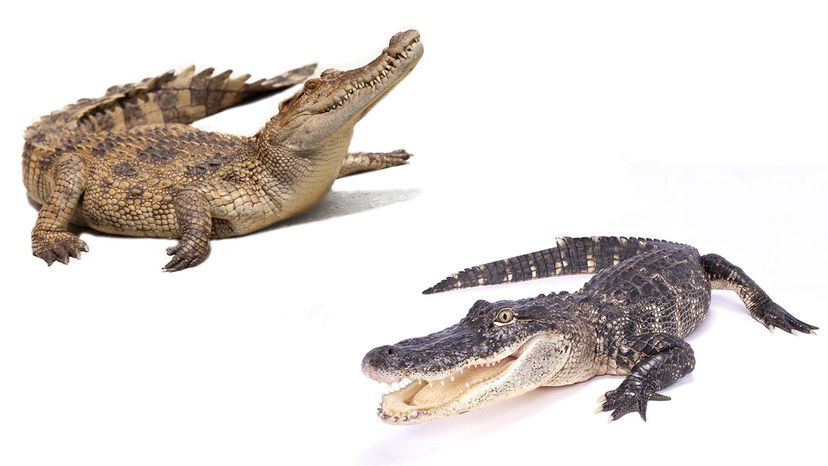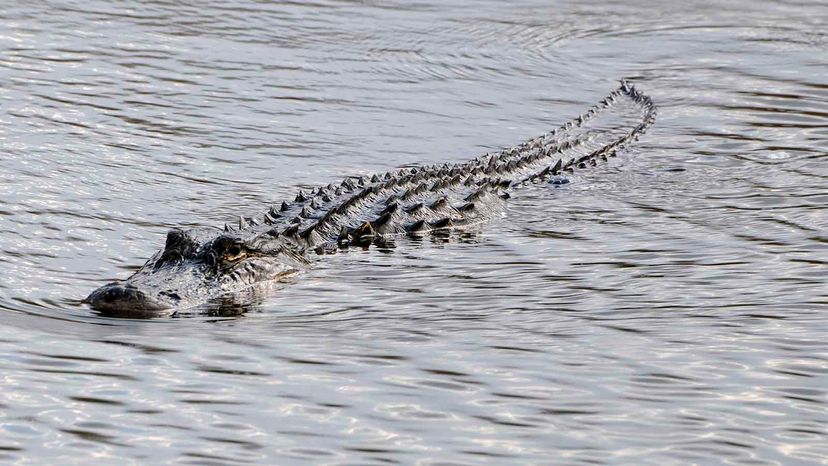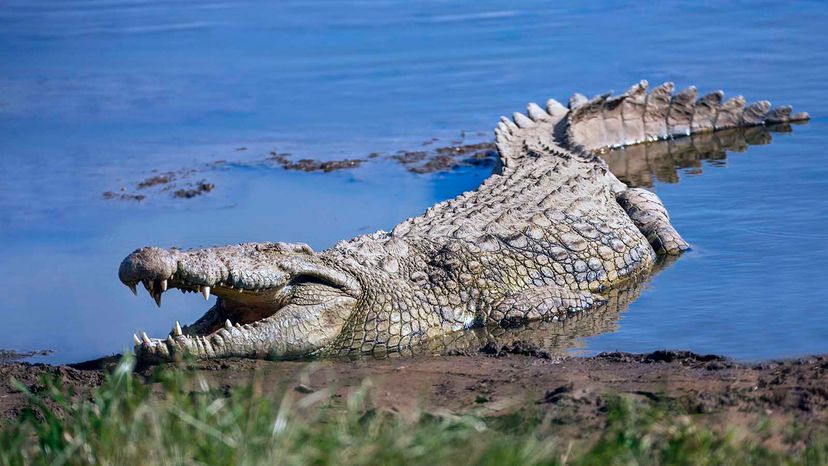
These two reptiles may seem indistinguishable from one another, but when you dive deeper (no pun intended), you'll find that there are several distinct characteristics that separate the alligator and the crocodile.
So what are some of them? First they're part of different families within the Crocodylia genus, and they also have different body sizes, snout shapes and habitats.
Advertisem*nt
Alligators and crocodiles live in both freshwater and saltwater environments, hunt the same types of prey, and they both have sensors on their skin that detect pressure changes and movement in the water. Although they share several similarities, there are a few other small details that separate these different species. Read on to learn more about these deadly, ancient reptiles.
Advertisem*nt
Contents
- Alligator vs. Crocodile: 4 Key Differences
- Common Alligator Species
- Common Crocodile Species
- Alligator vs. Crocodile: Which Predator Wins In a Head-to-Head Matchup?
- Alligator vs. Crocodile: Which Is More Dangerous to Humans?
Alligator vs. Crocodile: 4 Key Differences
Here are a few significant differences between these amphibious apex predators:
- A crocodile has a long, v-shaped snout, while alligators have wider, u-shaped snouts. One of the key contrasts between alligators and crocodiles is their snout shape. Crocodiles' v-shaped snouts and wider upper jaws allow them to hide their teeth and deliver a stronger bite, cracking through tough skin and hard-shelled turtles. (In fact, the saltwater crocodile has the second strongest animal bite in the world.) Both the upper and lower jaw of the alligator's rounded snout match up to hide the animal's lower teeth. A gator's u-shaped snout and crowded interlocking jaws make many of its lower teeth stick out of its mouth, especially its large fourth tooth.
- Alligators are significantly smaller than crocodiles. Alligators and crocodiles are extremely large reptiles, but in terms of average size, crocodiles are the larger of the two species. An adult male American alligator can grow to a maximum length of 14 feet (4.2 meters), while an adult crocodile can reach an astounding maximum length of 20 feet (6 meters). Some outlier specimens have been sighted in the wild, but there are few recorded cases of alligators and crocodiles surpassing these averages.
- Crocodiles tend to prefer brackish water near coastlines, while alligators live in primarily freshwater environments. This is one of the main reasons why you'll see zoo maintenance workers cleaning alligator pools in separate enclosures from their crocodilian counterparts. Although both alligators and crocodiles can survive for extended periods of time in either environment, most crocodiles live in brackish estuaries like the South Florida Everglades. Crocodiles can leave these saltwater environments and travel into freshwater hunting grounds because they possess lingual salt glands. Lingual salt glands excrete excess salt to regulate the crocodile's body cellular composition. These salt glands also help crocodiles complete this process without losing a significant amount of water, reducing the risk of dehydration.
- They have different feet. For instance, alligators have webbed feet, while crocodiles have separated toes. You can also identify a crocodile by its unique jagged fringe at its feet and hind legs.
Advertisem*nt
Common Alligator Species

Here are a few of the most common members of the Alligatoridae family:
American alligators: The American alligator is the largest species of the Alligatoridae family and is native to the Southern United States and northern regions of South America. Male alligators can grow up to 14 feet (4.2 meters) long, while females are typically smaller at a maximum of 10 feet (3 meters) in length. Wild alligators are endangered in South Florida and other Gulf states due to poaching, urban encroachment, and other forms of habitat loss. Yet, conservation efforts have increased the population to a more sustainable level in the Florida Everglades in recent years.
Advertisem*nt
Caimans: Caimans are a group of small- to medium-sized crocodilians that are native to Central and South America. They are smaller than both alligators and crocodiles and usually grow to be 6 to 8 feet (1.8 to 2.4 meters) long. Caimans have a u-shaped snout and sharp teeth for hunting fish and smaller game. You can find caimans in various swamps, lakes, and rivers throughout Central America, feeding on various fish, birds and other small prey from Mexico to Argentina.
Chinese alligators: The Chinese alligator is a critically endangered species that once roamed vast expanses of China's Yangtze River basin, but the only place you'll find them today is in a few provinces in East China. They are one of the smallest crocodilian species, typically growing to about 4 to 6 feet (1.2 to 2.4 meters) long. They have a wide upturned snout, a broad top jaw and a bony plate on the top of their skull that is not present in alligators in the Americas.
Advertisem*nt
Common Crocodile Species

There are 14 different species of "true" crocodiles in the world, and they all fall into one of these two categories:
Freshwater crocodiles: The Nile crocodile (Crocodylus niloticus) is one of the largest and most dangerous crocodiles in the world. Their size is on par with the American crocodile, with larger males growing to 20 feet (6 meters) long and 2,000 pounds (907 kilograms). Unlike their saltwater cousins, Nile crocodiles prefer freshwater areas in sub-Saharan Africa and follow a generalist diet of just about anything they can sink their large fourth tooth into.
Advertisem*nt
Saltwater crocodiles: Australian saltwater crocodiles (Crocodylus porosus) and American crocodiles (Crocodylus acutus) are the two most common subspecies of saltwater crocodiles. The title of largest crocodile species also goes to the saltwater croc.
Alligator vs. Crocodile: Which Predator Wins In a Head-to-Head Matchup?
The crocodile wins in a classic, Godzilla-style sci-fi channel matchup due to its sheer size and power. For example, the American crocodile can reach an average length of 20 feet, an average weight of 2,000 pounds, and has the strongest bite in the animal kingdom. Even without the alligator/crocodile size mismatch, American crocodiles tend to be more aggressive than American alligators. So, long story short, crocodiles win nine times out of 10.
Advertisem*nt
Alligator vs. Crocodile: Which Is More Dangerous to Humans?
Both alligators and crocodiles are instinctively afraid of people and will rarely attack humans. However, they may see children, pet dogs and other animals as potential prey if they are desperate.
Just because these creatures prefer to avoid people, it doesn't mean they will not attack humans when provoked. Keeping a safe distance and avoiding natural habitats is always the best course of action.
Advertisem*nt
It's also important to know that crocodiles and alligators are faster than they appear, and people shouldn't underestimate these creatures because of their lazy, sun-bathing nature. Full-grown crocodiles can reach top land speeds of 15 to 22 miles per hour (24 to 35 kilometers per hour), and once their top jaw and upper teeth lock down on an arm or leg, it can be nearly impossible to pry them loose. Therefore, this would be an "alligator vs. crocodile" question that you should be wary of testing in real life.
Now That's a Powerful Bite!
Crocodiles and alligators often stalk their prey along waterholes and coastlines. They are equipped with top-set eyes and natural motion sensors that allow them to stealthily move through the water into striking distance. Once in range, they can implement their strongest weapon — a locking mechanism between their top and bottom jaw and the strongest bite power in the animal kingdom. Once the upper and lower jaws are locked together, the bite can exert 3,700 pounds (1,678 kilograms) of pressure per square inch to immobilize their prey. The crocodile will then attempt to drag their victims into deeper water and drown them in a technique known as the "death roll."